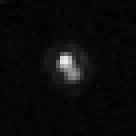 Hubble Space Telescope image of Ceto and Phorcys, taken in 2006 | |
| Discovery | |
|---|---|
| Discovered by | C. A. Trujillo and M. Brown |
| Discovery site | Palomar |
| Discovery date | 22 March 2003 |
| Designations | |
| (65489) Ceto | |
| Pronunciation | /ˈsiːtoʊ/ |
Named after | Ceto |
| 2003 FX128 | |
| TNO Centaur–extended[1] | |
| Adjectives | Cetoan /siːˈtoʊən/ or Cetoian /siːˈtoʊ.iən/ |
| Orbital characteristics[2] | |
| Epoch 13 January 2016 (JD 2457400.5) | |
| Uncertainty parameter 2 | |
| Observation arc | 9239 days (25.30 yr) |
| Aphelion | 187.74 AU (28.086 Tm) |
| Perihelion | 17.8498 AU (2.67029 Tm) |
| 102.79 AU (15.377 Tm) | |
| Eccentricity | 0.82635 |
| 1042.22 yr (380669.7 d) | |
| 9.1219° | |
| 0.00094570°/day | |
| Inclination | 22.266° |
| 171.85° | |
| 320.086° | |
| Known satellites | Phorcys /ˈfɔːrsɪs/ (171±10[3] ~ 132+6 −14 km[4] in diameter) |
| Earth MOID | 16.895 AU (2.5275 Tm) |
| Jupiter MOID | 12.7433 AU (1.90637 Tm) |
| Physical characteristics | |
| Dimensions | 223±10 km[3] 174+16 −18 km[4] |
| Mass | (5.4±0.4)×1018 kg (system)[4] |
Mean density | 1.37 g/cm3 (system)[4] |
Equatorial surface gravity | 3.3 cm/s2[4] |
| 4.43 h (0.185 d) | |
| 0.056±0.006[3] 0.084±0.02[4] | |
| 6.54±0.06,[3] 6.4[2] | |
65489 Ceto, as a binary also (65489) Ceto/Phorcys,[4] is a binary trans-Neptunian object (TNO) discovered on March 22, 2003, by Chad A. Trujillo and Michael Brown at Palomar. It is named after the sea goddess Ceto from Greek mythology. It came to perihelion in 1989.[2]
- ^ Marc W. Buie (2006-05-05). "Orbit Fit and Astrometric record for 65489". SwRI (Space Science Department). Retrieved 2009-01-25.
- ^ a b c "JPL Small-Body Database Browser: 65489 Ceto (2003 FX128)" (2006-05-05 last obs). Retrieved 25 March 2016.
- ^ a b c d Santos-Sanz, P., Lellouch, E., Fornasier, S., Kiss, C., Pal, A., Müller, T. G., Vilenius, E., Stansberry, J., Mommert, M., Delsanti, A., Mueller, M., Peixinho, N., Henry, F., Ortiz, J. L., Thirouin, A., Protopapa, S., Duffard, R., Szalai, N., Lim, T., Ejeta, C., Hartogh, P., Harris, A. W., & Rengel, M. (2012). “TNOs are Cool”: A Survey of the Transneptunian Region IV - Size/albedo characterization of 15 scattered disk and detached objects observed with Herschel Space Observatory-PACS
- ^ a b c d e f g Grundy, W.M.; Stansberry, J.A.; Noll K.S.; Stephens, D.C.; et al. (2007). "The orbit, mass, size, albedo, and density of (65489) Ceto/Phorcys: A tidally-evolved binary Centaur". Icarus. 191 (1): 286–297. arXiv:0704.1523. Bibcode:2007Icar..191..286G. doi:10.1016/j.icarus.2007.04.004. S2CID 1532765.